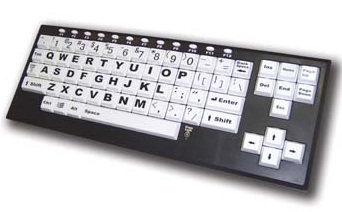Making Computers and the Internet More Accessible with Telikin
Author: Cheryl Lewis
20/40 in the other so I don't yet need glasses. However, when I used my PC to make a hotel reservation on a website recently, I struggled to visually navigate the site's extremely small print and very low color contrast which was light gray on a white background. Given how good my own eyesight is, I can only imagine how difficult navigating that website would be for someone with a low vision condition, such as macular degeneration. Then I began to consider the difficulties that people with other types of disabilities encounter when using the internet and/or a computer: motor impairments in the form of tremors, cerebral palsy, and paralysis; cognitive limitations resulting from developmental or acquired brain injury; and hearing loss and its communication challenges.
While there are a number of specialized software and hardware products that make computer access easier for certain disabilities, such as screen readers for the blind, speech-to-text for those with limited physical mobility, captioning for the deaf and hard of hearing, and assistive technology devices that allow those with serious physical and/or communication impairments to access a computer electronically; there are also relatively less complex website, software, and hardware enhancements that can vastly improve computer accessibility for all. Here are a few examples:
Size and Color
Larger font (at least 16 to 18 points) and icons, high color contrast between screen background and text, and the availability of screen magnifiers, all significantly improve readability. Individuals with glaucoma and macular degeneration benefit from extreme contrast and seem to favor light colors on dark colors, such as yellow text on a black background or white text on a dark blue background. Increased spacing between lines of text, as well as uncomplicated font styles with relatively wide letter spacing also advances the reading experience for the visually impaired.
Structured User Interface and Content
A simple, consistent, and structured user interface facilitates program and website navigation. Continuity in the appearance of screen content (buttons, fonts, headings, text boxes) between different applications streamlines usability. Screen content presented in an uncluttered and organized manner, with information presented in order of importance, makes it easier to visually scan and locate relevant information contained on the screen.
Hardware and Accessories
On the hardware side, a large touch screen, as well as the availability of an on-screen keyboard, aids computer access to those who may have difficulty using a mouse and physical keyboard. A stylus, which is a thin plastic pencil that one can use on a touch screen, can be useful to those with limited fine motor control in their hands and fingers. Physical keyboards with large keys and letters, or those with standard-sized keys whose letters are bigger and more visible, may be effective alternatives for those with fine motor and/or vision difficulties who struggle with using the on-screen version.
The concept of computer design described above, one that is useful to people with and without disabilities is also known as universal design. And if more website, software, and hardware designers subscribed to its basic tenet of accessibility for all, I may be able to delay getting those eyeglasses for a few more years.